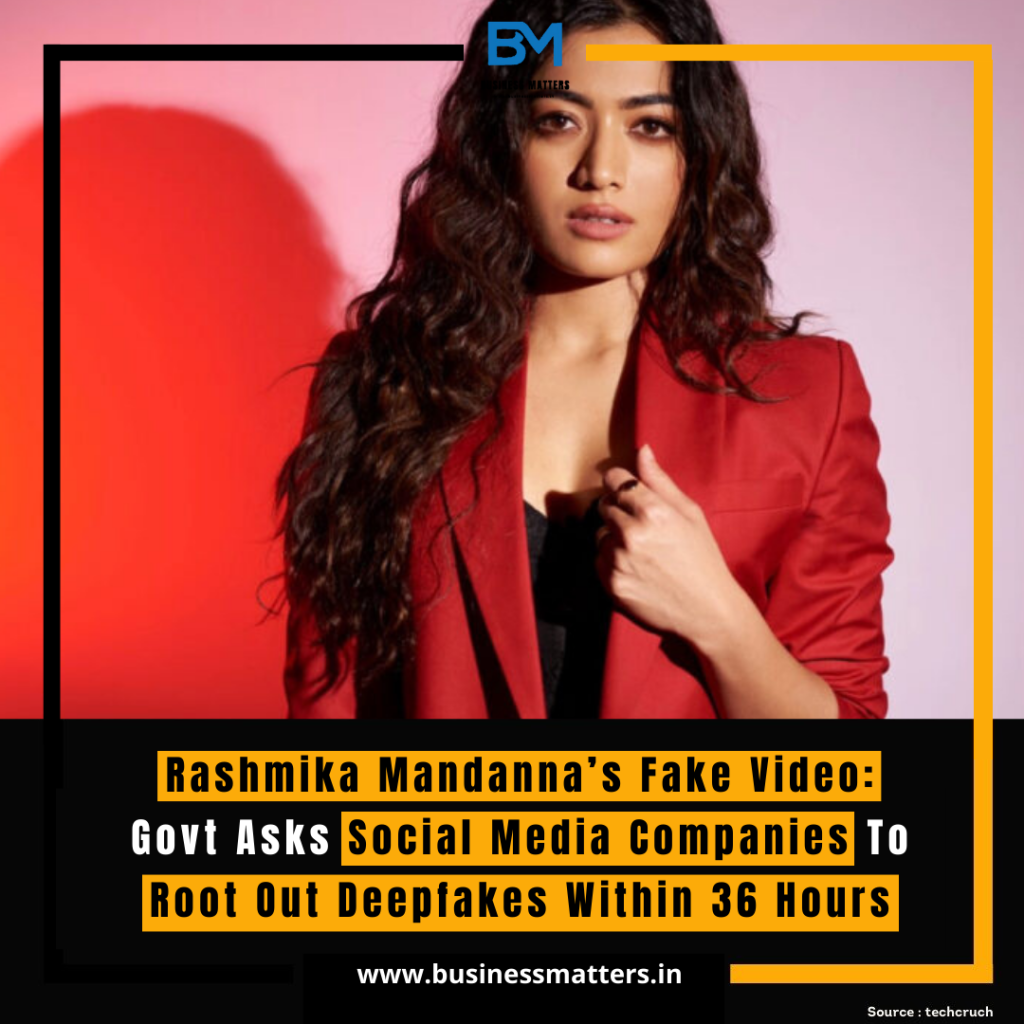
Government Urges Social Media Companies to Eliminate Rashmika Mandanna’s Deepfake Video Within 36 Hours
Government Urges Social Media Companies to Eliminate Rashmika Mandanna’s Deepfake Video Within 36 Hours
In recent years, the rise of deepfake technology has presented a growing challenge for governments, individuals, and businesses alike. Deepfakes, which involve the use of artificial intelligence to create highly convincing, but entirely fabricated, videos and audio recordings, have the potential to cause significant harm and disruption. The Indian government has recently taken a proactive stance in addressing the issue, particularly in light of a disturbing incident involving popular actress Rashmika Mandanna.
Rashmika Mandanna, a prominent figure in the Indian film industry, found herself at the center of a deepfake controversy when a video purportedly featuring her in a compromising situation began circulating on social media platforms. The video, which was entirely fabricated and manipulated using deepfake technology, threatened not only the actress’s reputation but also raised concerns about the misuse of this technology for malicious purposes.
In response to the emergence of the deepfake video, the Indian government swiftly took action, urging social media companies to take immediate steps to remove the video and identify its source within 36 hours. This move underscores the government’s commitment to addressing the rising threat of deepfakes and their potential consequences.
The Request to Social Media Companies
The request to social media companies was not a mere suggestion; it carried the weight of authority. The government’s concern was that such deepfake videos could not only harm the reputation of individuals but also have far-reaching implications for the nation’s security and societal fabric. The speed and accuracy with which deepfake videos can be created and disseminated make them a potent tool for misinformation and disinformation campaigns.
The government’s demand was clear: it expected social media platforms to act swiftly to remove the offending video and take measures to prevent its re-upload. Additionally, social media companies were tasked with identifying the individuals or groups responsible for creating and distributing the deepfake video.
The Challenge of Deepfakes
Deepfakes present a unique challenge because of their ability to manipulate audio and video content to a degree that is often indistinguishable from genuine recordings. This technology has been used in various ways, from impersonating political figures to creating fraudulent content for financial scams.
In the case of Rashmika Mandanna, the deepfake video not only damaged her reputation but also caused emotional distress and harm to her personally. Such incidents serve as stark reminders of the devastating potential of this technology, which can be weaponized to target individuals or manipulate public perception.
The Role of Social Media Companies
Social media companies play a crucial role in mitigating the spread and impact of deepfakes. They are the primary platforms through which such content is disseminated, making them pivotal in curbing the damage caused by deepfake videos. By complying with the government’s request, these companies can help maintain trust in their platforms and protect the integrity of their users.
To meet the 36-hour deadline, social media companies need to employ advanced content moderation algorithms and AI-driven detection tools. The use of machine learning and artificial intelligence can help in the swift identification of deepfake content and its removal. However, this requires continuous investment in technology and resources to stay ahead of the ever-evolving techniques used to create deepfakes.
The Challenges Faced by Social Media Companies
Eliminating deepfake content within 36 hours presents a significant challenge to social media companies. The speed at which content can go viral on these platforms can make it difficult to detect and remove it in such a short time frame. Additionally, the decentralized nature of social media means that content is often shared across multiple platforms, further complicating the task of identifying the source.
False positives also pose a risk. Content that is not a deepfake but may appear as one to automated detection systems could be wrongfully removed, potentially infringing on free speech and causing backlash from users.
Balancing the need to combat deepfakes with preserving free speech and privacy is a delicate and complex task. Social media companies must find a way to strike this balance while also complying with the government’s directive.
The Importance of Accountability
While the government’s request is a necessary step in addressing the deepfake problem, it also highlights the need for accountability. Those who create and disseminate deepfake content with malicious intent must be held responsible for their actions. Identifying the individuals or groups behind deepfake videos is crucial in deterring future incidents.
In this regard, the cooperation of social media companies is paramount. They have access to valuable data and tools that can aid in the investigation of such cases. The government should work in tandem with these companies to ensure that those responsible for creating and sharing deepfake content are brought to justice.
Protecting the Reputation of Individuals
Deepfakes can have severe and lasting consequences for individuals who become victims of this technology. The damage to one’s reputation, emotional distress, and potential harm to personal and professional relationships are all very real consequences. While technology can create such harmful content, it can also be part of the solution in identifying and removing it promptly.
Additionally, individuals who are targeted by deepfake content should have avenues for recourse and support. Laws and regulations surrounding deepfakes and their impact need to be continually updated to provide better protection for potential victims.
The Broader Implications
The incident involving Rashmika Mandanna’s deepfake video highlights the broader implications of the deepfake problem. While this particular video may have been created for malicious intent or personal gain, deepfake technology can also be exploited for political manipulation, fraud, and espionage.
Addressing the issue at its core requires a multi-pronged approach. This includes ongoing technological advancements in detection and prevention, updated legislation to combat the spread of deepfakes, and international cooperation to combat the global nature of this problem.
The Indian government’s proactive stance in addressing the deepfake issue, particularly when it involves public figures like Rashmika Mandanna, sets a precedent for the nation and sends a message that such actions will not be tolerated. It also serves as a reminder to social media companies that they have a responsibility to protect their users and maintain the integrity of their platforms.
In Conclusion
The emergence of deepfake technology has raised significant concerns regarding its potential to harm individuals, manipulate public perception, and disrupt societal norms. The Indian government’s request to social media companies to eliminate Rashmika Mandanna’s deepfake video within 36 hours is a crucial step in addressing these concerns.
The rapid and effective removal of deepfake content is a challenging task, but it is one that social media companies must take on to protect their users and the broader society. Simultaneously, efforts to identify and hold those responsible for creating and disseminating deepfakes should be pursued vigorously.
As the world grapples with the growing threat of deepfakes, proactive measures and cooperation between governments and tech companies are essential to safeguard the truth, protect individuals’ reputations, and maintain the integrity of digital platforms.

